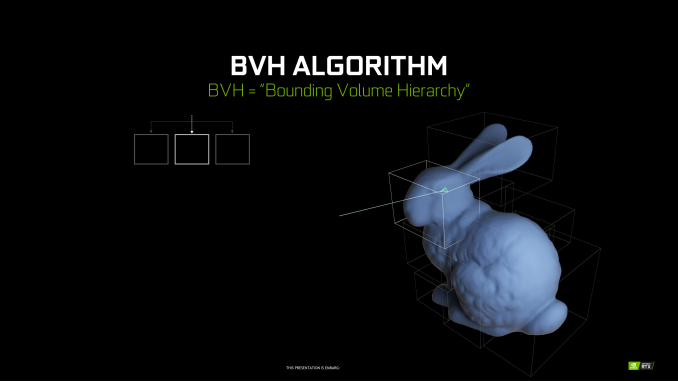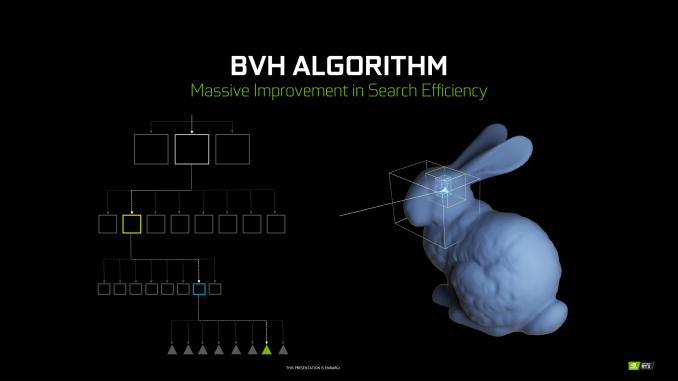The NVIDIA Turing GPU Architecture Deep Dive: Prelude to GeForce RTX
by Nate Oh on September 14, 2018 12:30 PM ESTBounding Volume Hierarchy - How Computers Test the World
Perhaps the biggest aspect of NVIDIA’s gamble on ray tracing is that traditional GPUs just aren’t very good at the task. They’re fast at rasterization and they’re even fast at parallel computing, however ray tracing does not map very well to either of those computing paradigms. Instead NVIDIA has to add hardware dedicated to ray tracing, which means devoting die space and power to hardware that cannot help with traditional rasterization.
A big part of that hardware, in turn, will go into solving the most basic problem of ray tracing: how do you figure out what a ray is intersecting with? The most common solution to this problem is to store triangles in a data structure that is well-suited for ray tracing. And this data structure is called a Bounding Volume Hierarchy.
Conceptually, a BVH is relatively simple – at least for the purposes of this article. Rather than testing every polygon to see if a ray interacts with it, the idea is to test a portion of a scene to see if it interacts with a ray, and then keep drilling down. If there is an intersection with that portion of the scene, then subdivide it into smaller portions and test again. And again. And again. All the way until you reach the individual polygon, at which point the ray testing is resolved.
For the computer scientists in the crowd, this might sound a lot like an application of a binary search, and it is. Each test allows for a significant number of options (in this case polygons) to be discarded as possible answers. This gets to the right polygon in just a fraction of the time. A BVH, in turn, is stored in what’s essentially a tree data structure, with each subdivision – called bounding boxes – stored as children of their parent bounding box.
Now the catch with BVH is that while it radically cuts down on the amount of ray intersection needed compared to a naïve implementation, it’s still not super cheap. A number of tests are still required for each ray, with both successful and failed tests adding to the total number of tests taken. And all of this is for a single ray, when a significant number of rays are going to be needed for each pixel. Which is why hardware acceleration of the process is so important (and not at all easy).
The other major computational cost here is that BVHs themselves aren’t free. One needs to be created for a scene from the polygons in it, so there is an additional step before ray casting can even begin. This is more a developer concern – when can they modify and reuse a BVH versus building a new one – but it’s another step in the process. Furthermore it’s an example of why developer training and efficient engine implementations are so crucial to the process, as a poor implementation can make ray tracing much too slow to be viable.













111 Comments
View All Comments
willis936 - Sunday, September 16, 2018 - link
Also in case there's anyone else in the signal integrity business reading this: does it bug anyone else that eye diagrams are always heatmaps without a colorbar legend? When I make eye diagrams I put a colorbar legend in to signify hits per mV*ps area. The only thing I see T&M companies do is specify how many samples are in the eye diagram but I don't think that's enough for easy apples to apples comparisons.Manch - Sunday, September 16, 2018 - link
No, bc heatmaps are std.willis936 - Monday, September 17, 2018 - link
A heatmap would still be used. The color alone has no meaning unless you know how many hits there are total. Even that is useless if you want to build a bathtub. The colorbar would actually tell you how many hits are in a region. This applies to all heatmaps.casperes1996 - Sunday, September 16, 2018 - link
Wow... I just started a computer science education recently, and I was recently tasked with implementing an effecient search algorithm that works on infinitely long data streams. I made it so it first checks for an upper boundary in the array, (and updates the lower boundary based on the upper one) and then does a binary search on that subarray. I feel like there's no better time to read this article since it talks about the BVH. I felt so clever when I read it and thought "That sounds a lot like a binary search" before the article then mentioned it itself!ballsystemlord - Sunday, September 16, 2018 - link
You made only 1 typo! Great job!"In any case, as most silicon design firms hvae leapfrogging design teams,"
Should be "have":
"In any case, as most silicon design firms have leapfrogging design teams,"
There is one more problem (stray 2 letter word), in your article, but I forgot were it was. Sorry.
Sherlock - Monday, September 17, 2018 - link
The fact that Microsoft has released a Ray Tracing specific API seems to suggest that the next XBox will support it. And considering AMD is the CPU/GPU partner for the next gen XBox - it seems highly likely that the next gen AMD GPU's will have dedicated Ray Tracing hardware as well. I expect meaningful use of these hardware feature only once the next gen console hardware is released - which is due in the next 2-3 years. RTX seems a wasteful expenditure for the end-consumer now. The only motivation for NVidia to release this now is so that consumers don't feel as they are behind the curve against AMD. This gives some semblance to the rumros that Nvidia will release a "GTX" line and expect it to be their volume selling product - with the RTX as proof-of-concept for early adoptersbebby - Monday, September 17, 2018 - link
Very good point from Sherlock. I also believe that Sony and Microsoft will be the ones defining what kind of hardware features will be used and which not.In general, with Moore's Law slowing down, progress gets slower and the incremental improvements are minimal. With the result that there is less competition, prices go up and there is not any more any "wow" effect coming with a new GPU. (last time I had this was with the 470gtx)
My disappointment lies with the power consumption. Nvidia should focus more on power consumption rather than performance if they ever want to have a decent market share in tablets/phablets.
levizx - Monday, September 17, 2018 - link
Actually the efficiency increased only 18% not 23%. 150% / 127% - 1 = 18.11%, you can't just 50% - 27% = 23%, the efficiency increase is compared to "without optimization" i.e. 127%rrinker - Monday, September 17, 2018 - link
91 comments (as I type this) and most of them are arguing over "boo hoo, it's too expensive" Well, if it's too expensive - don't buy it. Why complain? Oh yeah, because Internet. This is NOT just the same old GPU, just a little faster - this is something completely different, or at least, something with significant differences to the current cop of traditional GPUs. There's no surprise that it's going to be more expensive - if you are shocked at the price then you really MUST be living under a rock. The first new ANYTHING is always premium priced - there is no competition, it's a unique product, and there is a lot of development costs involved. CAN they sell it for less? Most likely, but their job is not to sell it for the lowest possible profit, it's to sell it for what the market will bear. Simple as that. Don't like it, don;t buy it. Absolutely NO ONE needs the latest and greatest on launch day. I won't be buying one of these, I do nothing that would benefit from the new features. Maybe in a few years, when everyone has raytracing, and the games I want to play require it - then I'll buy a card like this. Griping about pricing on something you don't need - priceless.eddman - Tuesday, September 18, 2018 - link
... except this is the first time we've had such a massive price jump in the past 18 years. Even 8800 series, which according to jensen was the biggest technology jump before 20 series, launched at about the same MSRP as the last gen.It does HYBRID, partial, limited ray-tracing, and? How does that justify such a massive price jump? If these cards are supposed to be the replacements for pascals, then they are damn overpriced COMPARED to them. This is not how generational pricing is supposed to be.
If these are supposed to be a new category, then why name them like that? Why not go with 2090 Ti, 2090, or something along those lines.
Since they haven't done that and considering they left and right compare these cards to pascal cards even in regular rasterized games, then I have to conclude they consider them generational replacements.